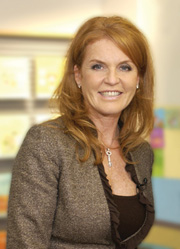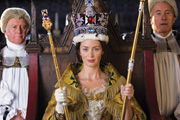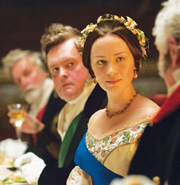Sarah Ferguson, the Duchess of York, co-produces the acclaimed new film ‘The Young Victoria’
The Duchess and the Queen
by Brandon Wolf
“Love never ages” says Sarah Ferguson, the Duchess of York. “That’s why Young Victoria is so relevant to today.”

Sitting in her suite at the Houstonian on a drizzly December morning, Ferguson talked recently with OutSmart about the new movie she has co-produced and which opened in Houston theaters on December 18. Aides bustle about in the somewhat cramped living room area of the suite. “Please turn on the lights,” she asks, “it’s rather gloomy in here.” Then she marvels at her bedroom that has a warm and crackling fireplace.
The Duchess, who recently turned 50, is trim and sleek in a tailored black suit. Her once-red hair is now a dark auburn, long and straight and falling gently on her shoulders. She is a woman on a mission, in the midst of a worldwide publicity tour to promote Young Victoria.
A local television crew wheels in large boxes of equipment and heads off to set up by the fireplace. An assistant leans over and carefully freshens her eyeliner and then dusts her cheeks with a light powder. Assured by the aide that she looks fine, Ferguson turns her attention back to the film she has come to Houston to publicize.
A Passion for Victoria
“Before I became a member of the British Royal Family, all I knew about Queen Victoria was what I learned at school,” the Duchess reflects. “We used to go to Albert Hall in London, and she really seemed distant—jowly, grumpy, and angry—very dark and black. We were taught about Victoria, but didn’t go into depth. But I always found history fascinating—I think it was the only exam I ever passed.”
Ferguson turns her eyes downward and continues, “When I married Prince Andrew, it was because I loved the man, not because he was a prince and a naval officer—although I got that as well. Two weeks after our wedding, the Buckingham Palace ‘handlers’ told us we would have to move into the second floor of the Palace. It was dark and gloomy, with the curtains constantly drawn.
“Then Andrew went off to sea, and I got to see him exactly 40 days a year for the first five years of our marriage. How can anyone sustain a relationship like that? I had my prince and naval officer, but where was my man? I was terribly sad because I missed him deeply, and I immersed myself in the love story between Victoria and Albert. In order to live out my own life, I had to see how she lived hers, and I thought if she could do it back then, I could do it now.”
Ferguson authored Victoria and Albert: a Family Life at Osborne House in 1991 and Travels with Queen Victoria in 1995. A copy of each rests on the coffee table in front of her. To research the books, she was given access by Queen Elizabeth II to The Royal Archives in Windsor Castle. “It was like a sweets shop for a historian,” she says with a sense of awe. “I was able to read Victoria’s diary and the love letters written between her and Albert.”
A Dream on Hold
In 1992 Ferguson first began thinking about a film of the young Victoria. “The diaries took me to a new understanding of Victoria,” she says. Opening one of her books, she holds up pictures of young Albert and Victoria. “You’d never believe that woman in black was once a woman with flowers in her hair and porcelain shoulders.”

Ferguson smiles and says that Albert adored everything about Victoria. Reading a diary excerpt, she recounts Victoria’s feelings when she was preparing to propose marriage to him: “I looked down the stairs and I saw at the bottom my tall, mustachioed man with a thin waist, and I knew immediately that I was in love.” Victoria found her opportunity at the end of a party: “All the guests had left except Albert. I shook his hand and he squeezed my hand twice. I knew then that I was safe to propose.”
In 1994 Ferguson approached a Hollywood studio with the idea of a film. The studio indicated they were interested, and engaged a screenwriter. “On the opening page of the script, it literally said, ‘Cut to Queen Victoria in bed with Lord Melbourne.’ I asked the writer how he could possibly have written that. It was so not on. He told me that I didn’t understand Hollywood. I tore up the script and walked away.”

Ferguson put her dream on hold for the next 10 years. During that time, she wrote several children’s books about Budgie the Helicopter, the helicopter in which she learned to fly and won her pilot’s license. She became a spokesperson for Weight Watchers and authored several books about weight control, eating to stay fit, how to re-invent oneself, and her autobiography.
She also worked with cancer education, emphasizing links between obesity and cancer. She championed numerous women’s issues and began the Sarah Ferguson Foundation, whose outreach is called Children in Crisis.
Ferguson chose to headquarter the Foundation in New York City, and the financial firm of Cantor Fitzgerald gave her an office in their suite on the 101st floor of the World Trade Center. On September 11, 2001, she appeared on the Today Show and then headed to her office, a 20-minute trip. As she left the NBC studio at 8:46 a.m., the first plane slammed into the North Tower, just a few floors below her office. Every employee at Cantor Fitzgerald died that day. One of the rag dolls given away by Children in Crisis was later pulled from the wreckage of the North Tower. Had Ferguson not accepted the invitation to the Today Show, she would have been in her office when the first plane hit that day.
On December 21, 2005, Ferguson was in London to celebrate singer Elton John’s civil partnership with his longtime partner David Furnish. A low-key ceremony was held at Guildhall, Windsor, followed by a lavish party which she attended at their Berkshire mansion.
A Dream Renewed
In 2004, Ferguson went back to Hollywood and was introduced to Graham King by a friend from Dallas. Sitting next to him, she told King that he should make a movie about young Victoria. “I told him it had to be all British with a British cast and it had to be huge,” she remembers. “I think I said it with so much passion and excitement that he said he would ‘go ahead and ask Marty.’ And I went, ‘Marty who?’ He answered ‘Martin Scorsese.’ I said, ‘Nah, he wouldn’t want it,’ but Graham said, ‘Yes he would, because he loves history.’”
Ferguson continues, extremely animated as she talks: “I went everywhere I could that Graham King was. I constantly annoyed him about the movie. Whenever he would see me at a premiere, he would say ‘Okay, I’ll make you a movie. Just don’t ask me again.’ I think he was eventually beaten down by me.”
As co-producer of the film, Ferguson played a large part in the selection of the cast and the approval of the screenplay. “I couldn’t have done this without the blessing of the Royal Family,” she says. “I would never do anything to harm my close friendships with Her Majesty and with Prince Andrew.
“Once I got to the point of making this happen, I stood back and just admired the brilliance of the whole team. I got very shy and didn’t want to possibly be a disruption to the filming, so I was rarely on the set. But I did have a friend who was fact-checking everything, making sure that the characters said ‘Your Royal Highness’ or ‘Your Majesty’ at the appropriate times. The huge banquet scene was completely authentic—the same silverware and china and tablecloths. The footmen measured the distance from the edge of the dining table to the edge of
the plates.”
Ferguson’s daughter, Princess Beatrice, has a quick cameo role as a lady-in-waiting during the coronation. “My other daughter, Princess Eugenie, was in boarding school, and they wouldn’t let me take her out to also play a cameo role,” she notes, mugging a scowl from Princess Eugenie. Ferguson had considered dressing up for a cameo role herself, but once again decided it would be better not to become a distraction from the filming.
“The real true British people and I get along very well,” says Ferguson. “But the chattering class sees me as a flea under the saddle. I held my breath before the premiere. I knew the movie would stand on its own, but I also knew they would have a go at me. It turned out that they didn’t because the film is just so good, they couldn’t. The film is now the top-selling DVD in Britain.”
Ferguson loved the coronation scene—“It was huge!”—and she found the film’s pivotal scene, a chess game between Albert and Victoria when they compare their lives to chess games, to be especially humorous and well-written.
When Albert died of typhoid at the age of 42, Victoria was broken, and her heart never mended. “How can I be alive when half of my body and soul is gone?” Ferguson reads from Victoria’s diary. Then she adds, “I don’t know how she managed after his death. He had not been just her husband. He had been her father, mother, friend, companion, advisor, lover, and guardian angel. Without him, she felt utterly lost.”
_______________________________
SIDEBAR: Queen of an Empire
But her heart belonged to only one
Young Victoria is a colorful and delightful way to learn history. If the image of a stern, aged woman in black is what pops into your mind when you think of Queen Victoria, this movie will be a revelation. The film follows Victoria as an isolated adolescent who becomes Queen of England at the unlikely age of 18. Sobered by such enormous responsibility, she finds the thought of marriage undesirable—until she discovers that her German first cousin, Albert, Duke of Saxony is attractive, intelligent, and interested. She also discovers him to be a soulmate, familiar with controlling relatives and conniving advisors. The two become inseparable allies and lovers.
In a reversal of traditional gender roles, Victoria is the powerful partner immersed in a demanding job, and Albert is left to serve as a trophy husband used ornamentally, whose opinions are not sought—or tolerated. Custom even dictated that Victoria, not Albert, propose marriage.
Their relationship becomes a war of wills until a day when Albert throws his body over Victoria’s during an assassination attempt. Realizing the depth of his love and facing the possibility of life without him, she forges a new relationship filled with consideration for his feelings and respect for his thoughts.
The film sparkles like the jewels in Victoria’s crown. The camera dwells lovingly on the English settings, the physical beauty of the actors and actresses, their costumes, and the sets. The coronation scene is awesome, filmed at the imposing Lincoln Cathedral which doubled for Westminster Abbey (and
also figured recently in The Da Vinci Code).
This movie will appeal to the refined senses of gay men, and Victoria’s strength will be appreciated by lesbians. The dialogue is witty, eloquent, and well delivered. Two particular verbal exchanges, one by Lord Melbourne and another by Pince Albert, are stunning for the sheer power of their incisive bitchiness. Apparently gay men aren’t the only males with tart tongues.
When the story concludes, do not leave the theater. The rolling credits are backed by a wonderfully soulful theme song that shouldn’t be missed—“Only You,” sung by Sinead O’Conner. This film will leave you feeling warm and fuzzy with romance—and wishing that O’Conner was singing for an intermission and not the end of the movie.
Brandon Wolf profiled Annise Parker in the June 2009 issue of OutSmart magazine.











Comments